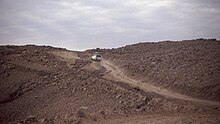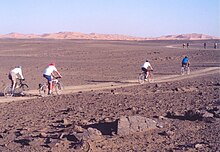Hammada


Hammada , also Hamada or Hamadah ( Arabic همادة hammāda , from hāmid /هامد / 'Dead, lifeless, solidified, extinct') is the name for rocky and stone deserts, especially within the Sahara . Rock and stone deserts are much more common than sandy deserts. The Sahara consists of 70 percent hammada.
The Hammadas are not filled with sand ( Erg ) or pebbles ( Serir ), but with angular stone fragments that were formed from plains from the Pluvial Age . The surface of this type of desert is densely littered with blocky, angular debris or rock material that has accumulated here as a result of physical weathering and the expansion of the fine material. In contrast to the loosely distributed rocks of the Hammada, the surface formation of the Reg forms a closed layer composed of different rock shapes and sizes.
Hammadas are very difficult or even impossible to traverse for vehicles and dromedaries .
Because of the extremely low water reserve in the rocky subsoil, Hammadas belong to the hostile desert regions. The vegetation is sparse as is desert. Since the bedrock is impermeable to water, the water runoff rates in rocky or stony deserts are particularly high, so the passage of the wadis that run through Hammadas is particularly dangerous.
The largest hammada is the Hammada du Draa in Western Sahara ; The Hammada al-Hamra in southern Libya and part of the Syrian Desert east of the Hauran region are also Hammadas.
literature
- Hans Murawski, Wilhelm Meyer: Geological dictionary . 10., rework. u. exp. Ed., 278, Enke Verlag, Stuttgart 1998, ISBN 3-432-84100-0 .
- Charles F. Gritzner: Deserts. Chelsea House Pub, New York 2006, p. 36, ISBN 978-0791092347
